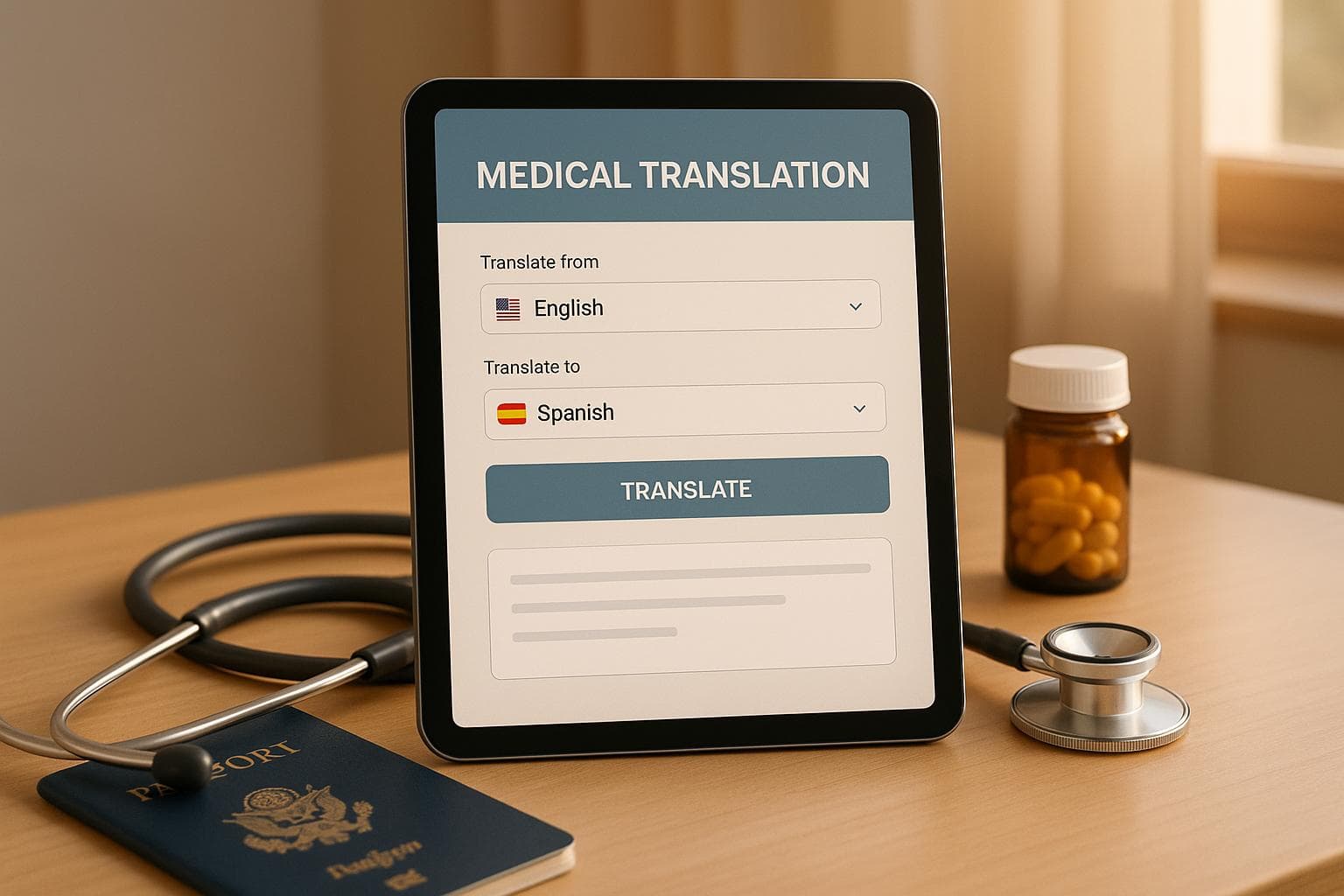5 Best Translation Tools for Medical Tourism
Looking for the best translation tools for medical tourism? Here's what you need to know upfront:
- Care to Translate: Tailored for healthcare with medically verified translations in 130+ languages. Offline mode and real-time features make it ideal for patient safety during travel.
- Google Translate: Free, supports 100+ languages, and offers offline functionality. Great for general use but less reliable for medical terminology.
- DeepL Translator: Known for high-quality translations, especially for European and Asian languages. Limited offline capabilities but excels in medical accuracy.
- iTranslate: Offers 100+ languages with offline packs and voice translation. Includes medical-specific features for better communication during consultations.
- Systran: Enterprise-level tool with advanced medical terminology support and real-time capabilities. Best suited for healthcare providers rather than individual travelers.
Quick Comparison Table:
| Tool | Languages Supported | Medical Accuracy | Offline Mode | Real-Time Features | Pricing |
|---|---|---|---|---|---|
| Care to Translate | 130+ | High | Yes | Yes | Premium options |
| Google Translate | 100+ | Moderate | Yes | Yes | Free |
| DeepL Translator | 31 | Very High | No | Yes | Freemium |
| iTranslate | 100+ | High | Limited | Yes | Freemium |
| Systran | 55 | Very High | Limited | Yes | Enterprise-level |
Why it matters: Accurate translation tools can prevent medical errors, ensure clear communication, and improve safety for international patients. Choose the tool that aligns with your needs - whether it's affordability, offline access, or medical precision.
This is Care to Translate - A digital medical translation tool (subtitles)
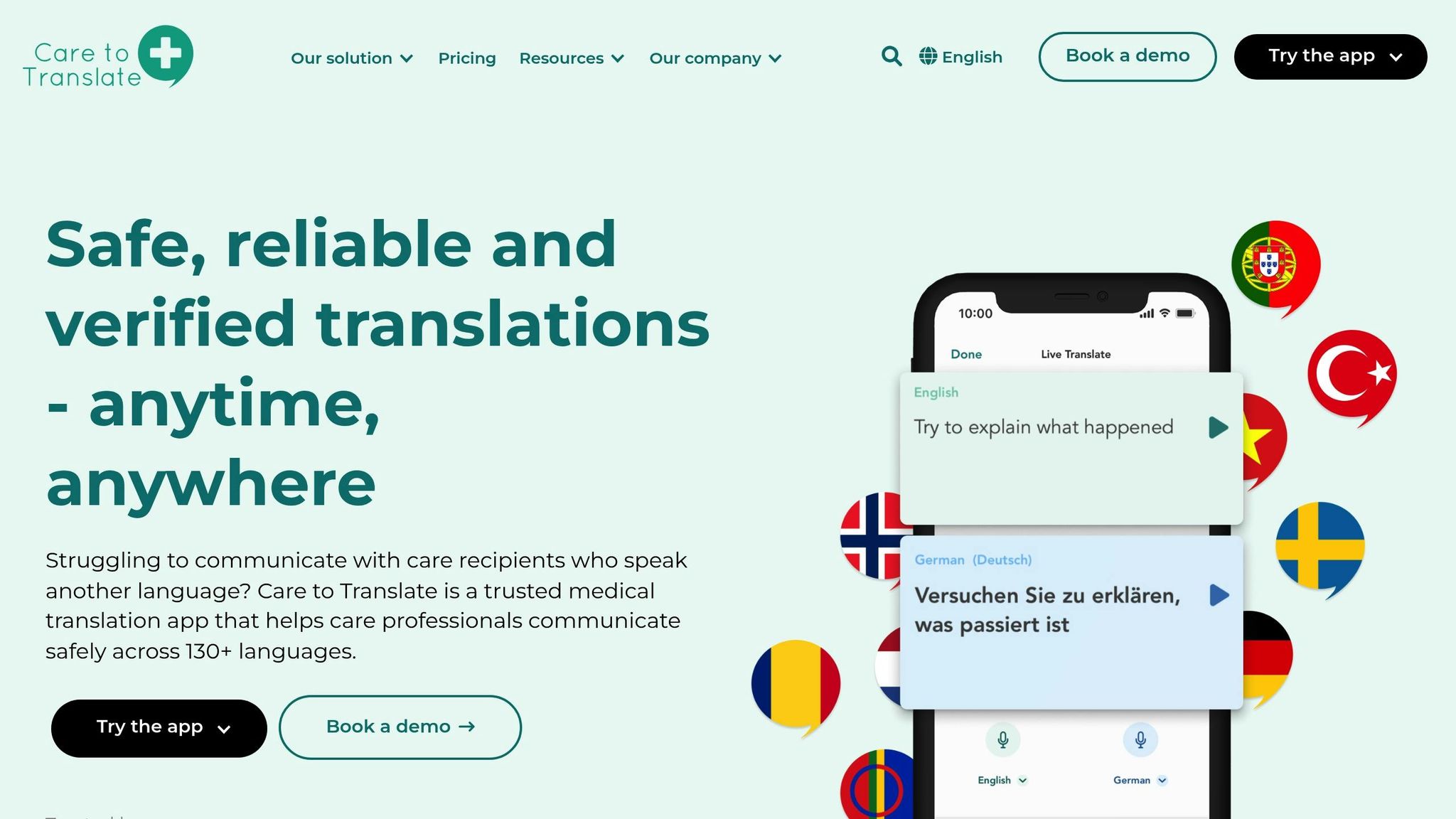
1. Systran
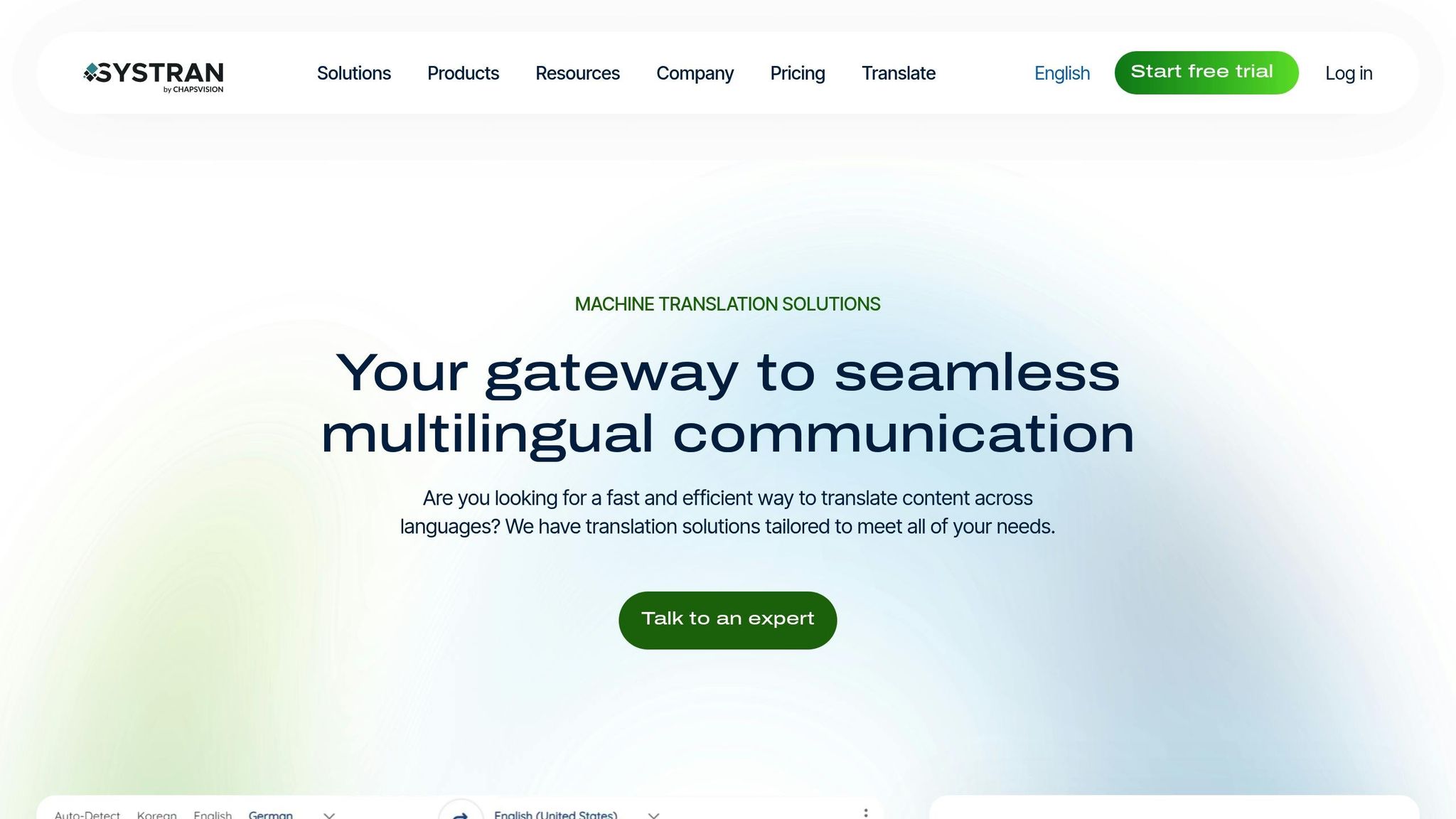
Systran has been a trusted name in translation services for over 40 years, offering fast and dependable solutions for medical translations. This enterprise-level platform can handle massive amounts of data, translating up to 6,000 words per second across its broad language network[3]. For medical tourists, who often require swift and accurate translations of complex healthcare documents, this speed can be a game-changer.
Supported Languages
With support for 55 languages spanning six major regions, Systran covers essential languages in Europe, Asia, and the Middle East & Africa[2]. This wide-ranging language support is especially helpful for medical tourists traveling to diverse destinations.
Medical Terminology Coverage
Systran stands out for its specialized focus on healthcare translations, boasting a comprehensive database of medical terms. Its machine translation services are tailored for therapeutic content, medical devices, and healthcare documents[1]. This customization ensures that critical documents - like prescription instructions, surgical consent forms, or detailed treatment plans - are translated with the accuracy and precision vital in medical contexts.
Real-time Capabilities
The platform offers real-time translation that integrates seamlessly with systems like Zendesk, making it a valuable tool for customer service and medical consultations[5]. Powered by AI and neural machine translation, Systran delivers context-aware translations that maintain the integrity of medical conversations - a crucial feature during emergencies or consultations[4]. Additionally, its design supports scalability and secure operations, making it ideal for high-demand environments.
Offline Functionality and Pricing
Systran is tailored for enterprise use, offering robust online performance and secure integration. It operates on a flexible enterprise pricing model, with costs depending on factors like usage volume, language pairs, and customization needs. While this pricing structure may not suit individual medical tourists with limited budgets, it's a worthwhile investment for agencies and healthcare providers managing large volumes of international patients.
Its strong emphasis on data security and compliance makes it a reliable choice for handling sensitive medical information. However, its enterprise-oriented focus might not align with the needs of every individual user.
2. Google Translate
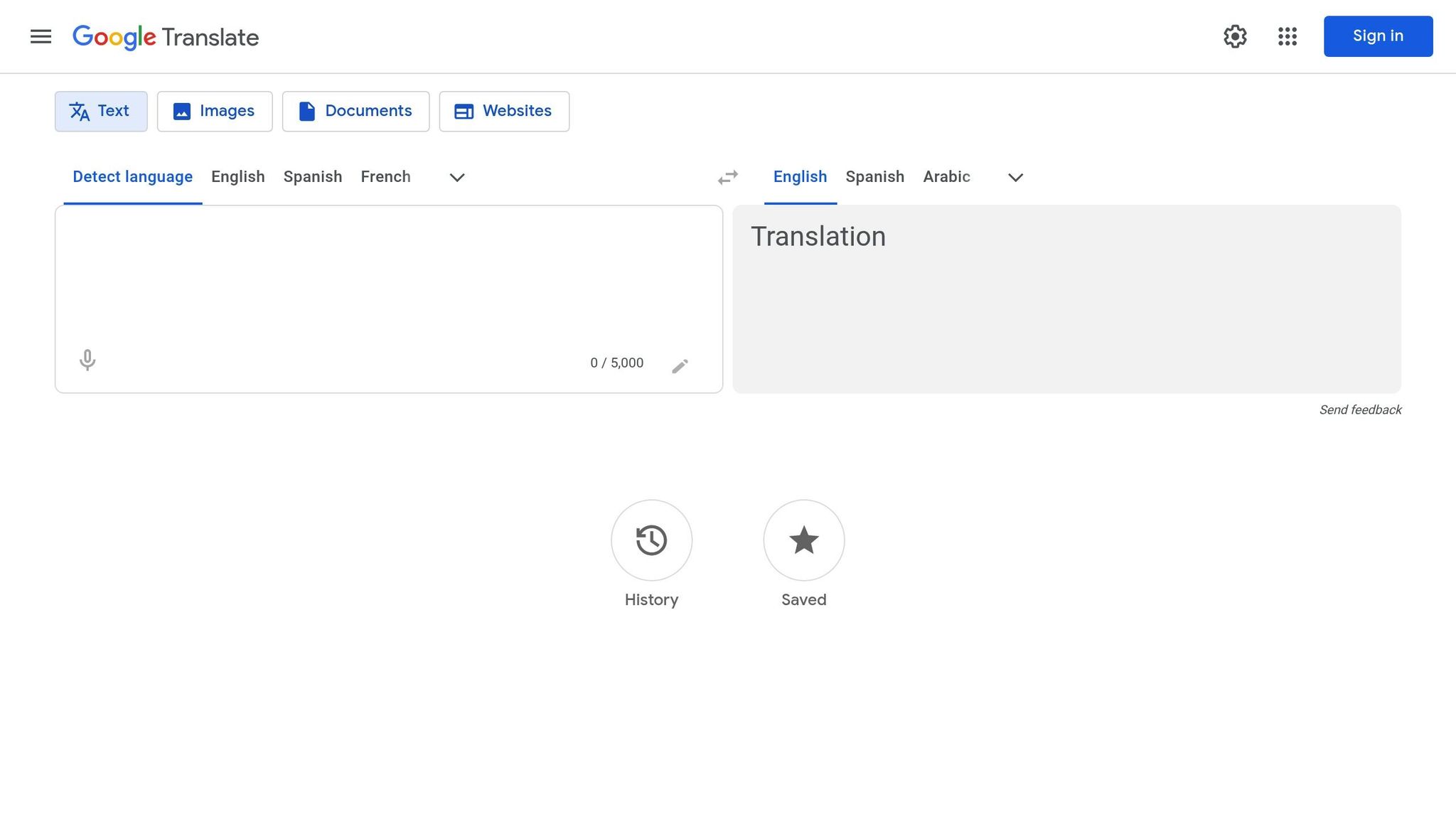
Google Translate, with its over 1 billion users, has become a go-to tool for medical tourists seeking accessible and convenient translation services. However, its use in healthcare settings comes with certain limitations that require careful consideration.
Supported Languages
With support for over 100 languages, Google Translate stands out as one of the most extensive translation platforms available[8]. It includes languages from popular medical tourism destinations worldwide, ranging from widely spoken European languages to less common ones like Swahili and Icelandic[8]. The ability to translate between any combination of these languages offers flexibility for travelers heading to diverse destinations[7]. While this broad coverage is a strength, translating specialized medical terms remains a challenge.
Medical Terminology Coverage
Google Translate excels in everyday translations but struggles with medical terminology. Since adopting Neural Machine Translation in 2016, its overall accuracy has reached 94%[9]. However, when it comes to medical phrases, accuracy can drop to as low as 57.7%, with significant variation depending on the language[10][11].
The consequences of medical mistranslations can be serious. Lisa Diamond, a Health Disparities Researcher at Memorial Sloan Kettering Cancer Center, highlights the risks:
"All you need is one error that creates confusion for a patient, and they don't take their blood thinner, or they take too much of their blood thinner, and you end up with a medical emergency."[12]
Given that 55% of malpractice suits are linked to miscommunication[13], healthcare providers must be cautious when relying on Google Translate for critical medical information.
Real-time Capabilities
Google Translate offers real-time features like voice, camera, and handwriting input, which are particularly useful during medical consultations[8]. These tools enable patients to interact with healthcare providers in multiple ways, and the ability to translate entire web pages can further enhance communication[8]. While these features are impressive, the platform’s accuracy in medical settings remains a concern.
Offline Functionality
For travelers in areas with limited connectivity, Google Translate provides downloadable language packs for offline use[14]. However, offline functionality is restricted to text translation - features like voice, real-time conversation, and camera translation require an internet connection[15]. Despite these limitations, the offline option can be a lifesaver for those in remote locations.
Pricing
Google Translate is completely free for personal use, making it an appealing choice for many travelers despite its shortcomings in medical accuracy.
3. DeepL Translator
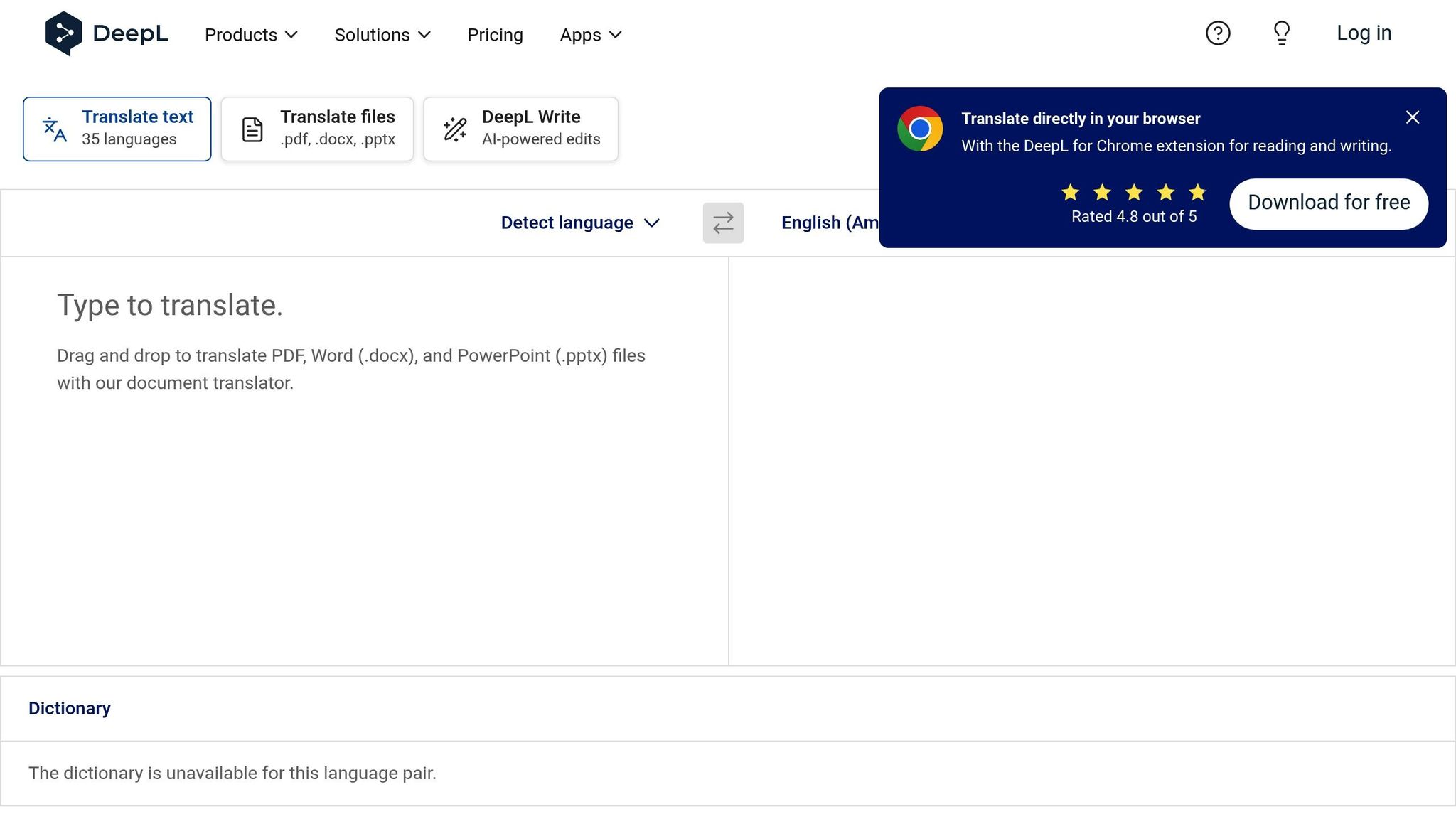
DeepL Translator has become a favorite among language professionals for its impressive translation quality. For medical tourists who value precision over a broad range of languages, it’s a strong contender. Let’s take a closer look at its language options, medical terminology capabilities, pricing, and connectivity.
Supported Languages
DeepL supports over 1,000 language combinations across 31 languages, focusing mainly on major European and select Asian languages[16][19]. While this narrower focus ensures top-notch translations for popular destinations, it may not cover less common languages. Notably, a 2024 survey by the Association of Language Companies revealed that 82% of language service providers rely on DeepL for their translation needs[17].
Medical Terminology Coverage
DeepL excels at translating complex medical terms, boasting a specialized medical model with over 95% accuracy[21]. In a 2021 study analyzing a Japanese-to-English medical article, DeepL achieved 94% overall accuracy. It was particularly strong in the 'Results' section with 100% accuracy, though slightly lower at 89% in the 'Materials and Methods' section. Experts rated its translations as 1.3 times more accurate than Google’s[20][17]. Additionally, DeepL offers a glossary feature, allowing users to save and manage terminology lists for consistent translations of key medical terms[18].
Pricing
DeepL uses a freemium model, which works well for occasional translations. For more frequent or advanced use, premium plans provide higher limits and added features.
Offline Functionality
One limitation of DeepL is its reliance on an internet connection, making it less practical in areas with poor connectivity[22].
sbb-itb-3922076
4. iTranslate
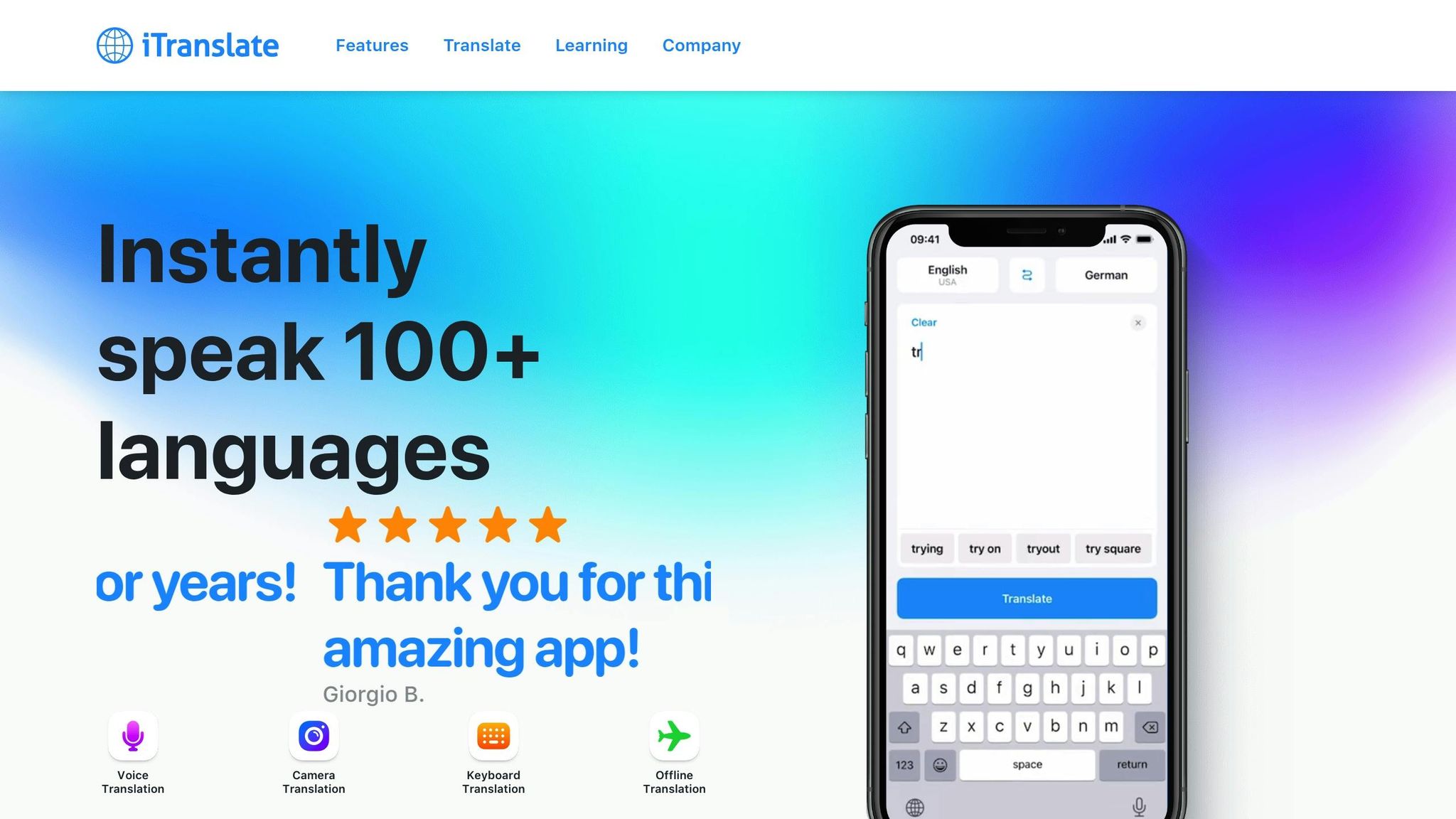
iTranslate is a handy app for medical travelers, offering offline functionality and medical-specific features to tackle the challenges of navigating remote destinations without reliable internet access.
Supported Languages
With text translation available in over 100 languages and 9,900 language combinations, iTranslate connects medical tourists across the globe [23]. For voice translation, it supports 38 languages, covering most major languages spoken in popular medical tourism destinations [25]. Beyond its broad language support, it includes specialized tools tailored for medical use.
Medical Terminology Coverage
Designed to meet HIPAA standards for healthcare translation [24], iTranslate Medical focuses on delivering accurate medical communication. It currently supports English, Spanish, French, German, and Mandarin Chinese, with plans to expand its language options. The app includes medical terminology in its translations, making it suitable for both clinical interactions and everyday travel scenarios [26].
Real-time Capabilities
iTranslate simplifies real-time communication with its voice translation feature. Speak into the app and get instant translations, ensuring clarity during medical consultations. Additionally, the camera translation function allows users to translate medical documents, prescriptions, or signage by pointing their phone's camera at the text [26]. The app's use of Deep Neural Network models for speech recognition and translation enhances the accuracy of these medical interactions [24].
Offline Functionality
One of iTranslate's standout features is its offline mode, which supports translation between 38 languages, offering over 1,300 language pairs [25]. By downloading language packs in advance, users can access text translations for 41 languages, voice conversations, and even custom phrasebooks without needing an internet connection [27]. This is especially useful for travelers in areas with limited or unreliable connectivity.
Pricing
iTranslate operates on a freemium model, offering basic features for free. Premium subscriptions unlock advanced tools like unlimited translations, offline language packs, and camera translation. The iTranslate Medical version is tailored for professional healthcare use, with pricing dependent on institutional needs and HIPAA compliance requirements [24].
5. Care to Translate
Care to Translate is a healthcare translation app designed to prioritize clinical precision and patient safety.
Supported Languages
The app supports over 130 languages and includes a phrase library that allows translations of medical terms in 47 languages [28]. Its extensive language options make it especially helpful for travelers navigating healthcare systems in different regions. More languages are currently being developed to expand its reach [28].
Medical Terminology Coverage
One of the app’s standout features is its focus on medically verified translations, tailored specifically for healthcare settings [26]. This level of precision is crucial, as studies show that miscommunication in medical environments can lead to serious misunderstandings. By bridging these language gaps, Care to Translate addresses a critical need for accuracy.
Real-time Capabilities
The app also offers an optional real-time translation feature, available as an add-on to its phrase library [28]. This feature ensures instant communication during consultations when pre-loaded phrases might not suffice. Translations are available in both text and audio formats [28], making it easier for medical tourists to interact with healthcare providers who may prefer spoken communication. Clare Gilliland, a Digital Lead Midwife in the UK, praised the app, stating:
"The app allows us to communicate simple instructions in seconds, saving valuable time compared to arranging phone-based translation." [28]
Offline Functionality
Care to Translate includes a robust offline mode, enabling users to download the entire phrase library or specific playlists in their preferred language directly to their device [29]. This feature ensures that users can access essential medical phrases even without an internet connection [29]. For medical tourists in areas with unreliable internet, this offline capability is a dependable solution, especially during emergencies [29].
Pricing
The app’s pricing model is straightforward, centering on access to the core phrase library. For users needing more advanced communication options, the real-time translation add-on is available at an additional cost [28]. This flexible pricing makes it an accessible choice for a wide range of users.
Translation Tools Comparison
Choosing the right translation tool can make all the difference in medical tourism. Below is a table summarizing key features to help you compare and decide which tool aligns with your needs.
| Tool | Supported Languages | Medical Terminology | Real-Time Text | Real-Time Voice | Real-Time Image | Offline Mode | Pricing (USD) | Platform Availability |
|---|---|---|---|---|---|---|---|---|
| Systran | 55 languages | General translation with extensive database [30] | Yes | Yes | Yes | Limited | N/A | Web, iOS, Android |
| Google Translate | 100+ languages | General translation | Yes [6] | Yes [6] | Yes [6] | Yes [32] | Free | Web, iOS, Android |
| DeepL Translator | 31 languages | High-quality general translation [32] | Yes | Yes | Yes | No | N/A | Web, iOS, Android |
| iTranslate | 100+ languages | General translation [6] | Yes [6] | Yes [6] | Yes (Pro) [6] | Limited (Pro) | N/A | Web, iOS, Android |
| Care to Translate | 130+ languages | Medically verified translations [30] | Yes | Yes | No | N/A | Premium with 20% discount [28] | iOS, Android |
Each tool has its strengths, making it suitable for different aspects of medical tourism:
- Google Translate stands out with support for over 100 languages, full offline text translation, and no cost [32]. While it’s versatile, it lacks the precision needed for medical terminology.
- Care to Translate is tailored specifically for healthcare, offering medically verified translations in 130+ languages [30]. This focus can enhance patient understanding and compliance with treatment plans - critical for accurate communication [31].
- DeepL Translator delivers exceptional translation quality for its 31 supported languages but doesn’t offer offline capabilities [32].
- iTranslate balances features with premium options like image translation and limited offline functionality.
- Systran, with its extensive database, is better suited for healthcare facilities handling broad language needs rather than individual travelers [30].
When selecting a tool, prioritize features that matter most to you. For medical tourists, offline functionality and accurate medical terminology are often non-negotiable. Tools like Care to Translate ensure accurate communication, safeguarding health outcomes by addressing critical language and cultural nuances. Accurate translations not only prevent misunderstandings but also help patients feel valued and respected throughout their healthcare journey [30].
Conclusion
Choosing the right translation tool for medical tourism comes down to three key factors: accuracy, affordability, and ease of use. As we’ve seen in our comparison, each tool serves a distinct purpose - whether it’s the free accessibility of Google Translate or the medical precision offered by Care to Translate.
Miscommunication in medical tourism isn’t just inconvenient - it can directly affect patient safety and treatment outcomes. With the global medical translation services market expected to hit $6.42 billion by 2028 [35], the need for precise and reliable translation tools is growing alongside the industry itself.
For international travelers, translation apps are handy for everyday conversations, but when it comes to critical medical information, it’s essential to consult professional interpreters. Always request written summaries of diagnoses and treatment plans in your native language to avoid misunderstandings [33].
Healthcare providers, on the other hand, should prioritize tools that deliver accurate medical terminology and consider the nuances of different languages. For complex cases, combining machine translations with a human review ensures better outcomes [34].
Each of the five tools reviewed offers a specific advantage: Google Translate is ideal for budget-conscious travelers, Care to Translate excels in medical accuracy, DeepL Translator delivers high-quality translations, iTranslate provides a well-rounded feature set, and Systran is a great choice for healthcare facilities handling diverse language needs. By choosing the right tool for the right purpose, both patients and providers can ensure effective communication for safer international healthcare.
Additionally, partnering with accredited agencies like Explore Medical Tourism can help bridge any remaining language gaps, ensuring access to trusted care across borders. Reliable translation tools, combined with professional support, are essential for safeguarding your health while traveling abroad.
FAQs
::: faq
How does Care to Translate ensure accurate medical translations for patients and healthcare providers?
Care to Translate emphasizes precision by blending cutting-edge technology with the skills of experienced professionals. Their platform relies on trained medical interpreters and adheres to professional translation standards, ensuring translations are both accurate and contextually appropriate - especially for intricate medical documents. Unlike platforms that depend solely on automated translation, Care to Translate prioritizes the accuracy and sensitivity essential in healthcare, making it easier to close communication gaps effectively. :::
::: faq
What are the risks of using Google Translate for medical terms, and how could it impact patient safety?
Google Translate often falls short when it comes to translating medical terminology, particularly with complex or highly specialized terms. This can create significant communication issues, such as misinterpreted symptoms, unclear treatment instructions, or inaccuracies in medical histories. Since the tool lacks the ability to fully grasp context or regional dialects, it often produces overly literal translations that can lead to confusion - or worse, errors in medical decisions.
Such mistakes can have serious consequences for patient safety. Misdiagnoses, incorrect treatments, or delays in urgent care are just a few of the potential risks. In critical healthcare situations, depending solely on automated tools like Google Translate is not advisable, as it undermines the accuracy and clarity essential for effective medical communication. :::
::: faq
What is the best translation tool for offline use when traveling to areas with limited internet access?
For those venturing into areas with spotty or no internet access, Translator Offline is a dependable option. It allows you to translate languages without needing to be online, making it easier to communicate in unfamiliar settings. This can be especially critical for medical tourism, where precise translations are essential for understanding and accessing healthcare services overseas. :::
